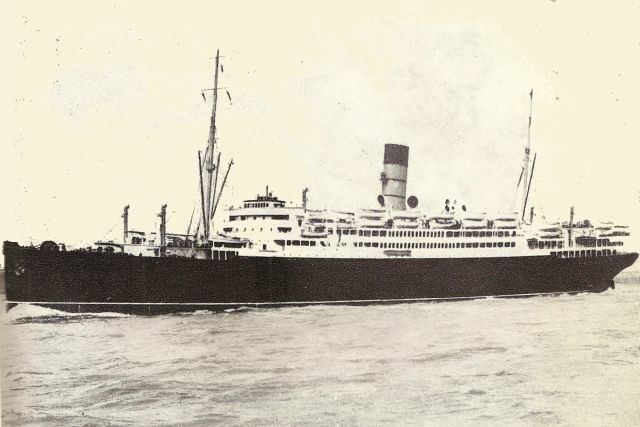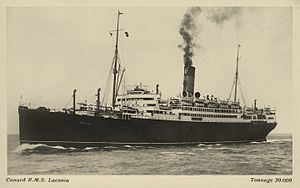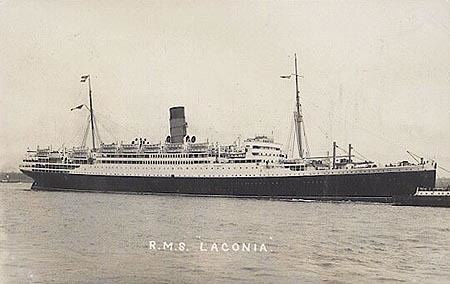Name Laconia Completed January 1922 Length 183 m Beam 22 m | Launched 9 April 1921 Draft 9.96 m Builder Swan Hunter | |
 | ||
Operator 1921–34 Cunard Line1934–41 Cunard White Star Line Route Liverpool – Boston – New York | ||
The second RMS Laconia was a Cunard ocean liner, built by Swan, Hunter & Wigham Richardson as a successor of the 1911-1917 Laconia. The new ship was launched on 9 April 1921, and made her maiden voyage on 25 May 1922 from Southampton to New York City. At the outbreak of World War II she was converted into an Armed Merchant Cruiser, and subsequently a troopship. Like her predecessor, sunk during the First World War, this Laconia was also destroyed by a German submarine. Some estimates of the death toll have suggested that over 1,649 people were killed when the Laconia sank. The U-boat commander Werner Hartenstein then staged a dramatic effort to rescue the passengers and the crew of Laconia, which involved additional German U-boats and became known as the Laconia incident.
Contents

Description

Laconia was 601 feet 3 inches (183.26 m) long, with a beam of 73 feet 7 inches (22.43 m). She had a depth of 40 feet 6 inches (12.34 m) and a draught of 32 feet 8 inches (9.96 m). She was powered by six steam turbines of 2,561 nhp, which drove twin screw propellors via double reduction gearing. The turbines were made by the Wallsend Slipway & Engineering Company, Newcastle upon Tyne. In addition to her passenger accommodation, Laconia had 54,089 cubic feet (1,531.6 m3) of refrigerated cargo space.
Early career

Laconia was built by Swan, Hunter & Wigham Richardson Ltd, Wallsend, Northumberland. Launched on 9 April 1921, she was completed in January 1922. Her port of registry was Liverpool. The code letters KLWT and United Kingdom Official Number 145925 were allocated. As a Royal Mail Ship, Laconia was entitled to display the Royal Mail "crown" logo as a part of its crest. In January 1923 Laconia began the first around-the-world cruise, which lasted 130 days and called at 22 ports.
On 8 September 1925, Laconia collided with the British schooner Lucia P. Dow in the Atlantic Ocean 60 nautical miles (110 km) east of Nantucket, Massachusetts, United States. Laconia towed the schooner for 120 nautical miles (220 km) before handing the tow over to the American tug Resolute. In 1934, her code letters were changed to GJCD. On 24 September 1934 Laconia was involved in a collision off the US coast, while travelling from Boston to New York in dense fog. It rammed into the port side of Pan Royal, a US freighter. Both ships suffered serious damage but were able to proceed under their own steam. Laconia returned to New York for repairs, and resumed cruising in 1935.
Drafted into war service

On 4 September 1939, Laconia was requisitioned by the Admiralty and converted into an armed merchant cruiser. By January 1940 she had been fitted with eight six-inch guns and two three-inch high-angle guns. After trials off the Isle of Wight, she embarked gold bullion and sailed for Portland, Maine and Halifax, Nova Scotia on 23 January. She spent the next few months escorting convoys to Bermuda and to points in the mid-Atlantic, where they would join up with other convoys.
On 9 June, she ran aground in the Bedford Basin at Halifax, suffering considerable damage, and repairs were not completed till the end of July. In October her passenger accommodation was dismantled and some areas filled with oil drums to provide extra buoyancy so that she would stay afloat longer if torpedoed.
During the period June–August 1941 Laconia returned to St John, New Brunswick and was refitted, then returned to Liverpool to be used as a troop transport for the rest of the war. On 12 September 1941, she arrived at Bidston Dock, Birkenhead and was taken over by Cammell Laird and Company to be converted. By early 1942 the work was complete, and for the next six months she made trooping voyages to the Middle East. On one such voyage the ship was used to carry prisoners of war, mainly Italian. She travelled to Cape Town and then set a course for Freetown, following a zigzag course and undertaking evasive steering during the night.
Final moments
On 12 September 1942, at 8:10 pm, 130 miles (210 km) north-northeast of Ascension Island, Laconia was hit on the starboard side by a torpedo fired by U-boat U-156. There was an explosion in the hold and many of the Italian prisoners aboard were killed instantly. The vessel immediately took a list to starboard and settled heavily by the stern. Captain Rudolph Sharp, who had also commanded another famous Cunard liner, RMS Lancastria when she was sunk by enemy action, was gaining control over the situation when a second torpedo hit Number Two hold. At the time of the attack, the Laconia was carrying 268 British soldiers, 160 Polish soldiers (who were on guard), 80 civilians, and 1,800 Italian prisoners of war.
Captain Sharp ordered the ship abandoned and the women, children and injured taken into the lifeboats first. By this time, the ship's stern deck was awash. Some of the 32 lifeboats had been destroyed by the explosions and some surviving Italian prisoners tried to rush the lowering of the ones that remained. The efforts of the Polish guards were instrumental in controlling the chaotic situation on board and saved many lives. According to Italian survivors, many of the POWs were left locked in the holds, and those who escaped and tried to board lifeboats and liferafts were shot or bayoneted by British and Polish soldiers. While most British and Polish troops and crew survived, only 415 Italians were rescued, out of 1,809 who had been onboard.
At 9:11 pm Laconia sank, stern first, her bow rising to be vertical, with Sharp himself and many of the Italian prisoners still on board. The prospects for those who escaped the ship were only slightly better; sharks were common in the area and the lifeboats were adrift in the mid-Atlantic with little hope of rescue.
However, before Laconia went down, U-156 surfaced. The U-boat's efforts to rescue survivors of its own attack began what came to be known as the Laconia incident.
When Kapitänleutnant Werner Hartenstein, commanding officer of U-156, realized civilians and prisoners of war were on board, he surfaced to rescue survivors, and asked BdU (the U-Boat Command in Germany) for help. Several U-Boats were dispatched; all flew Red Cross flags, and signalled by radio that a rescue operation was underway.
The next morning, a U.S. B-24 Liberator plane sighted the rescue efforts. Hartenstein signaled the pilot for assistance, who then notified the American base on Ascension Island of the situation. The senior officer on duty there, Robert C. Richardson III, unaware of the Germans' radio message, ordered that the U-boats be attacked. Despite the Red Cross flags, the survivors crowded on the submarines' decks and the towed lifeboats, the B-24 then started making attack runs on U-156. The Germans ordered their submarines to dive, abandoning many survivors. After the incident, Admiral Karl Dönitz issued the Laconia Order, henceforth ordering his commanders not to rescue survivors after attacks. Vichy French ships rescued 1,083 persons from the lifeboats and took aboard those picked up by the four submarines, and in all around 1,500 survived the sinking. Other sources state that only 1,083 survived and an estimated 1,658 persons died (98 crew members, 133 passengers, 33 Polish guards and 1,394 Italian prisoners).
Amongst the French ships involved in the rescue were Annamite, Dumont-d'Urville and Gloire.
Media
On 6 and 7 January 2011, BBC2 in the United Kingdom broadcast The Sinking of the Laconia, a two-part dramatisation of the sinking of Laconia.
